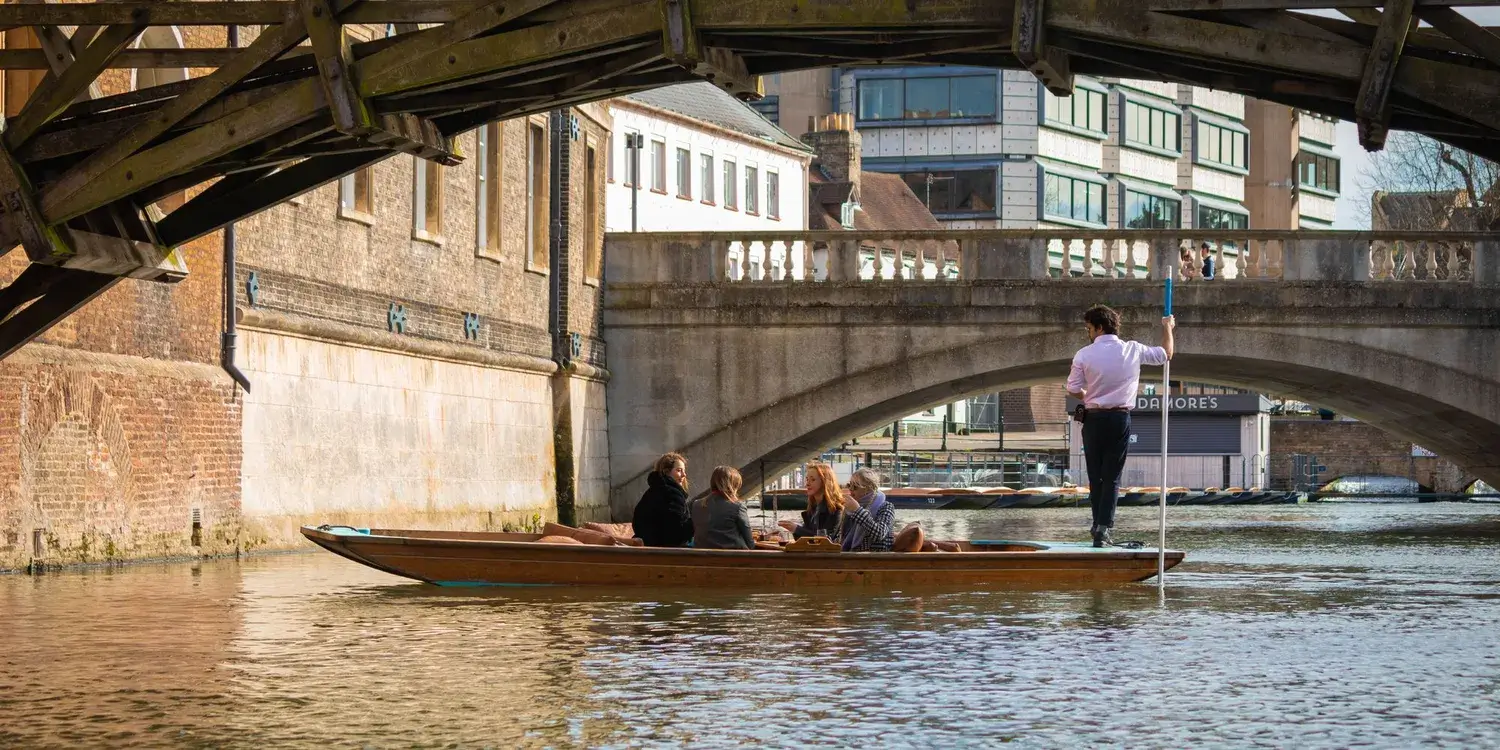6 Lies told on punting tours in Cambridge

“History is written by the victors“
Winston Churchill
…he may have said this, but he wasn’t the first to say this, and yet people still think he originated the phrase.
When it comes to punting in Cambridge, it’s easy to think that everything the tour guide is saying has been verified by a score of sober unbiased academics. I would dare not insult your intelligence to suggest that you actually thought that was true, or that sober unbiased academics even exist!
Hi, my name is Max. I was a tour guide, and now I go on weird rants.
While we can accept some things tour guides say may get embellished, these are six popular tall tales that you’re almost certain to hear on the river (not from our guides) which we can guarantee are not true.
1. Prince Charles’ Bodyguard
Ah, this has been a favourite fib of many a tour guide over many a year!
While he did have a bodyguard while studying at Trinity College, who did discreetly sit in on his lectures and seminars, the bodyguard did NOT take the same exam as the Prince, and therefore did NOT get a better grade than the Prince.
There are plenty of poetic and ironic moments in life, like the fact Charles studied Archeology & Anthropology (the two things all princes need to learn about: old things and people), but any interesting stories about his bodyguard are as fictional as the film The Bodyguard, or the more recent TV show Bodyguard.
2. The Stone Ball on Clare Bridge
There’s a college in Cambridge. It’s called Clare College.
They have a bridge at this college. It’s called Clare Bridge.
….really invigorating stuff there, ain’t it?
Anywho, one of the 14 stone balls that decorates Clare Bridge at Clare College has a mysterious slice taken out of it.
Sadly, this is not an episode of the Netflix show, Is It Cake? Many entertainingly preposterous theories as to why there is a wedge taken out of the stone ball have appeared over time.
One tour guide might claim the architect, Thomas Grumbold, was underpaid so took the rest of his payment in stone.
Another will claim the college did it to avoid the Bridge Tax (which is a thing?) as it would then be classified as ‘incomplete’.
And then another tour guide, who didn’t hear the first two, will say it was removed by a drunken fellow who betted another drunken fellow there wasn’t 14 stone balls on the bridge and didn’t want to pay up.
All funny takes on the missing wedge, none of them true. To be fair, the truth is really boring.
See, the metal spike that attaches the ball to the bridge needed to be repaired, so they had to take out a wedge to reach it, and then they didn’t put it back. The end.….moving on.
3. The Race That Never Happened
No, don’t worry, the boat race between Cambridge and Oxford has happened, and continues to happen every year, and we continue to pretend like it’s a big deal that will change our lives forever.
There is also a cardboard boat race the students have every year, testing their feats of construction. That would be more fun to talk about, but oh well.
I’m talking about the supposed race between St. John’s and Trinity College to build their clock tower first, with the victor being allowed to have a clock installed in it. This is APPARENTLY the reason why St. John’s New Court has a big circle where a clock is supposed to go.
Seems a bit unfair if it was true, since Trinity started building their clock tower in 1726, and St. Johns started building the New Court where the clock tower is in 1825. Very cheeky head start there. Or more likely, very fabricated story there.
The truth as to why the New Court has a clockless clock tower remains a mystery. A more likely theory was that St. John’s may have bankrupted themselves in trying to show off their wealth, and so had no funds to have a clock installed when the building was finally completed.
Alas, though, if nobody is willing to practice necromancy or make a time machine so we can get a first hand account of what happened, then we may never never truly know what happened.
Oxford and Cambridge have had a longstanding rivalry for many years: you can read more about Punting Oxford VS Cambridge in our guide.
4. Alan Turing’s Apple
(TRIGGER WARNING: HOMOPHOBIA, SUICIDE)
This is a bit depressing to talk about, and frankly it feels a bit gross to bring up, but this lie is a personal irk of mine.
Feel free to skip this lie, we understand…
Occasionally tour guides seem to think that because Alan Turing studied at King’s College, that everyone wants to spend their nice trip punting down the river with their loved ones hearing about his demise, with nasty chemical castration due to a conviction for his homosexuality. This resulted in his suicide, from cyanide poisoning and when he was found, there was a half-eaten apple next to him.
Why focus on this area of his life? In truth, this is so the guides can then look smart by claiming Turing’s untested apple was the inspiration for the branding of Apple Computers and their famous logo with the bite taken out of the apple…..
Yeah, sadly not at all the case, so the insensitive tour guide who needlessly focused on chemical castration and suicide just so he can try and look smart, did so only to proliferate a lie.
No, Apple Inc. did not draw inspiration from Turing for its name or logo. The name was chosen by Jobs after spending time on an apple orchard and thought it sounded “Fun, spirited, and not intimidating”. And there is a bite taken out of the apple in the logo so that it looks like an apple regardless of the size.
My hope from mentioning all this is that the more people will call out anyone who reiterates this lie, to the point where no tour guide focuses on the tragedy of Turing unless you as a customer request to know more.
5. The House That Is White That is Not The White House
The building next to King’s College Chapel is called The Gibbs’ Building, and it looks alot like The White House in Washington D.C. This is probably why people assumed the building was the inspiration for the White House, and some guides decided this was true and went further to claim both buildings were designed by the same architect.
Nevertheless, unless the architect behind The Gibb’s Building, James Gibbs (1682 – 1754), was reincarnated as James Hoban (1755 – 1831), the architect behind The White House, then this is pure coincidence at best and a flat out lie at worst.
And before you think The Gibb’s Building might have inspired Hobin’s design for The White House, I’d like to draw your attention to The Leinster House in Dublin, the actual source of inspiration for The White House.
If you wanna educate your guide, it could be worth mentioning that The Gibb’s Building was made of Portland Stone, a naturally white stone, while The White House was made from Aquia Creek Sandstone which was then painted white. So, technically, The Gibb’s Building is the REAL white house.
6. The Bridge Of Lies
Surprisingly the ol’ Clare Bridge at Clare College is not the one that’s known as “The Bridge Of Lies” in Cambridge. That title has been awarded to the enigmatic Mathematical Bridge.
For a long time, everyone thought that Issac Newton, or that dude who invented the falling thing, as the youth might say, designed the bridge.
Everyone also believed that it was originally built without any bolts.
On top of that, it was thought some students took it apart to uncover its secrets, but couldn’t put it back together again so that’s why they’re bolts in it now. Sounds like a really bad nursery rhyme….
….Newty Dewty built a wood bridge
Made from only a free-standing ridge
It was taken apart by dumb college men
Who couldn’t put it back together again
I have no idea why I wasted brain power on that, ‘cause none of it is true. If a tour guide says any of this but doesn’t follow it up by admitting as such, you have my permission to call them out on it.
The bridge was designed in 1749, 22 years after Newton died. It was designed by a man called William Etheridge. It was always bolted together, but in theory it doesn’t need them. It’s not so much that the bridge is supported by its own weight, but that because of its simple yet elegant design, it becomes stronger the heavier the weight on the bridge becomes, JUST LIKE ME!
There you have it!
There is more to learn, but I have to save something for when you come down for your very own Cambridge punting tour.
I hope this pontification has been enlightening, entertaining, and not too traumatising to read. If you hear any tour guide say any of these lies, or as they might call them, “unverified truths”, don’t be afraid to call them out, but be kind. They just want you to have a good time after all. Happy Punting!


